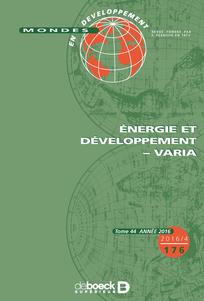Projets d'accès à l'électricité : comment en mesurer les bénéfices ?
 |
Electricity Access Projects: How to Measure their Benefits ?
article Oct 2016 ; 17 pages
Aut. Pascal Augareils & Clara Kayser-Bril
Ed. De Boeck Supérieur - Paris
Downloadable format: PdF
Downloadable from the publisher
Editor Presentation
Résumé:
Si le caractère bénéfique des programmes d’électrification fait consensus, ces bénéfices sont rarement définis et quantifiés. La méthode de la chaîne causale permet d’en définir l’étendue – mais comment les mesurer en pratique ? Les auteurs proposent plusieurs approches et présentent deux exemples d’application sur des projets concrets : calcul du surplus du consommateur dans le cadre d’un projet d’électrification rurale au Libéria, enquête sur les perceptions des bénéficiaires dans un contexte d’électrification périurbaine au Tchad. Abstract:
Electricity Access Projects: How to Measure their Benefits ?
Beyond the global consensus that electricity access programs have important positive impacts, the actual benefits are difficult to assess precisely. The causal chain method allows us to define what “benefits” mean, but how can they be measured in the field? The authors review several approaches to that end and
give concrete examples from two real-life cases: a calculation of consumer surplus for rural electrification in Liberia, and a survey of the perceived benefits of a suburban electrification project in Chad.
Target Audiences:
University , Cooperation actors , Socio-Economist , Economist
Keywords: |
cost savings (CI) (DT) (ET) (ope) , costs, tariffs (CI) (DT) (ET) (ope) , electrification (CI) (DT) (ET) (ope) , management practices / governance (CI) (DT) (ET) (ope) , peri-urban (CI) (DT) (ET) (ope) |
Countries: |
Publisher/Broadcaster: |
|
De Boeck Supérieur - Paris |
If there is a broken link, we will be pleased to receive a message: communication@pseau.org